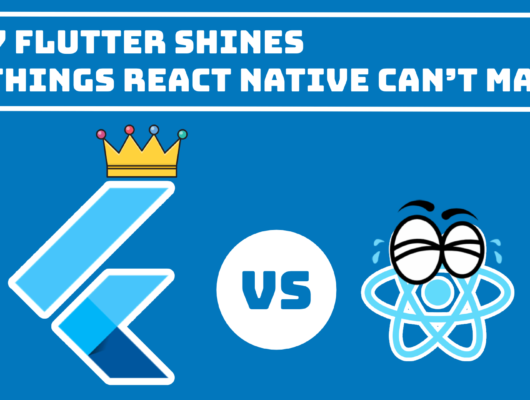Building a cross-platform app in 2025?
Then, choosing between Flutter and React Native can be a tough call.
Both are incredibly capable of cross-platform app development and let’s discuss which one to choose.
The Cross-Platform Struggle is Real
Remember when building a mobile app meant maintaining two separate codebases. Yes, one for iOS and another for Android.
Thankfully, those days are behind us, but now we face a new challenge – Which cross-platform framework to use? Flutter or React Native?
Why This Decision Matter More Than Ever in 2025?
Because,
- Users won’t tolerate slow or clunky apps
- Development teams are leaner
- The tech moves faster than ever
So, while choosing a tech stack for development, a developer or business owners need to think ahead and choose wisely.
5 Key Differences You Need to Know
1) Performance
Flutter compiles directly to native ARM code using Dart’s AOT compilation and provides near-native performance with consistent 120fps animations with its impeller rendering engine.
React Native has significantly improved with its Fabric renderer and TurboModules by reducing JavaScript bridge overhead by about 60%. However, it still can’t quite match Flutter’s raw performance, especially for complex animations
Real-world tests show that Flutter apps have 15-20% faster UI rendering than React Native.
2) Developer Experience
Flutter’s Hot Reload remains an industry-leading game changer that makes changes appear instantly while preserving app state. Plus, the widget-based system provides excellent UI control.
React Native is easier to pick up for JavaScript/React developers. Its Fast Refresh is okay but not as good as Hot Reload.
3) UI Development
Flutter gives you pixel-perfect control over every UI element with its comprehensive widget library. When it comes to theming and platform-adaptive widgets, it works beautifully out of the box.
React Native still relies more on community libraries for UI components. This can lead to inconsistency, and it requires dipping into native code for advanced customization
4) Ecosystem & Community
Flutter’s ecosystem has grown massively, and now has over 25,000 packages. Google’s strong backup provides excellent documentation and long-term support.
React Native has the larger community overall with access to npm’s 2.1 million packages.
5) Programming Language
Flutter uses Dart, an object-oriented language by Google with features like strong typing, garbage collection, and async support. If you are familiar with modern OOP languages, Dart feels intuitive and robust for app development.
TypeScript, a statically typed superset of JavaScript, excels in reusing JS libraries and frameworks. However, it is limited by JavaScript’s core structure, while Dart offers a more complete OOP experience.
Winner
In 2025, both Flutter and React Native are powerful, production-ready frameworks but according to me, Flutter is the winner here!
Choose Flutter if you want,
- High performance
- Beautiful custom UIs
- One codebase for mobile, web, and desktop
- Design-heavy apps
- Long-term scalability
Choose React Native if you want,
- Faster development with JavaScript/TypeScript
- Easier onboarding for web developers
- Native look and feel using platform-specific components
- Strong community support and wide adoption
At the end of the day, the best choice depends on your team’s skills and your app’s goals.
But if you’re starting fresh in 2025 and planning to build new apps using Flutter, feel free to talk to our Flutter experts here.





